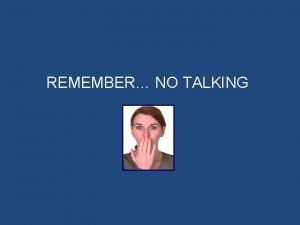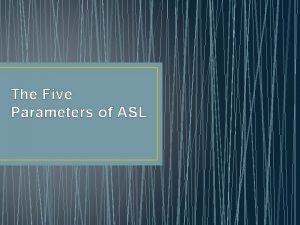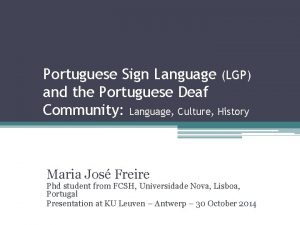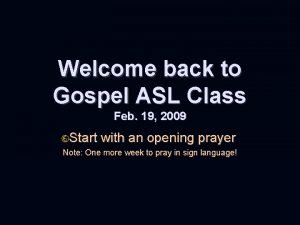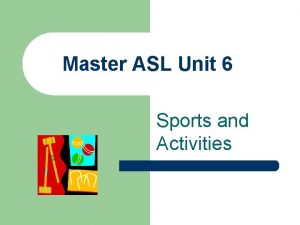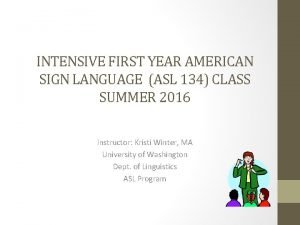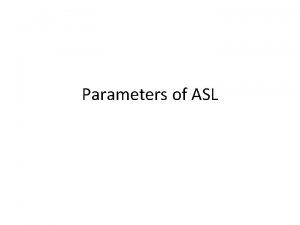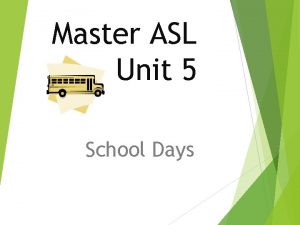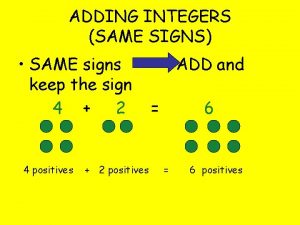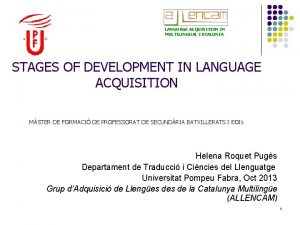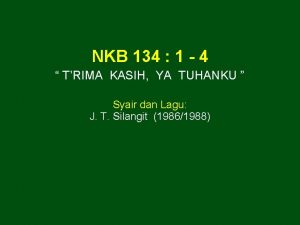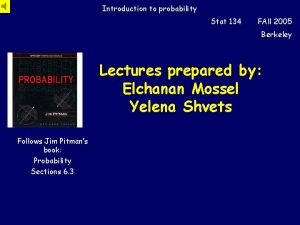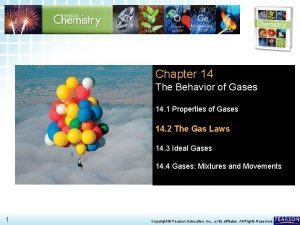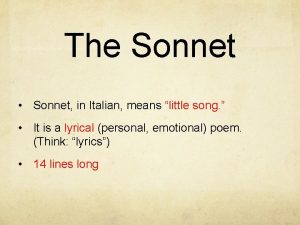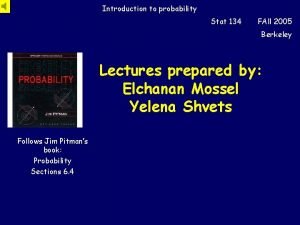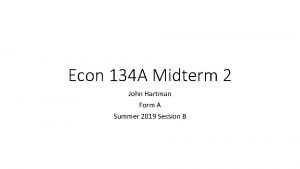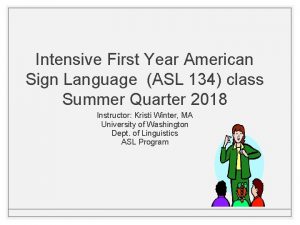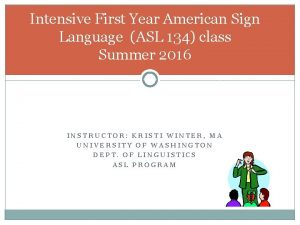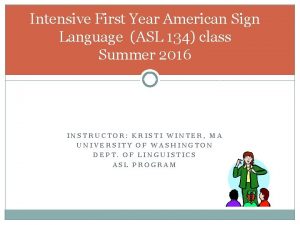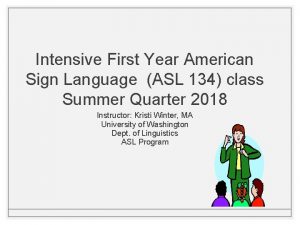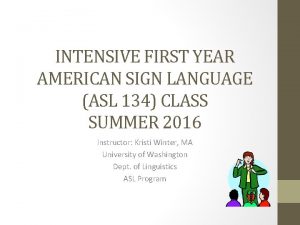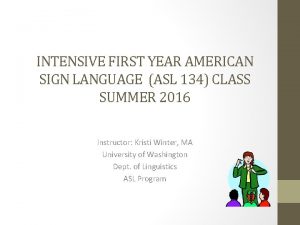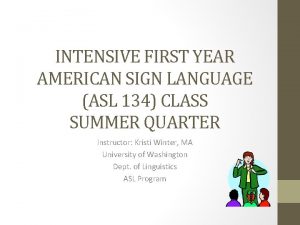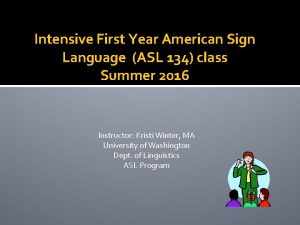Intensive First Year American Sign Language ASL 134





























- Slides: 29

Intensive First Year American Sign Language (ASL 134) class Summer Quarter Instructor: Kristi Winter, MA University of Washington Dept. of Linguistics ASL Program

Schedule: � Today: � SN Unit 4 “Talking about Family” � Video: “For a Deaf Son” � Signing Lunch (12: 45 pm – 1: 30 pm) � Thursday, July 12 th � SN Unit 4 � Video: “Mom & Dad, Your Deaf Child is Ok”

Language Acquisition / Deaf Education �Why ASL? �http: //aslized. org/library/#/lightbox&slide=34 �Early Intervention: The Missing Link (with audio) �http: //aslized. org/library/#/lightbox&slide=31

Unit 4 Talking about Family

Homework 4: 1 (pages 179 -180) �Minidialogues: �Minidialogue 1 1. What does Tyrone compare/contrast? � How many children Anna had with two of her husbands. How many more children does Anna want? 2. � None.

Homework 4: 1 (pages 179 -180) �Minidialogues: �Minidialogue 2 What does David compare/contrast? 1. � � How many sons and daughters her sister has. Whether children were deaf or hearing. When did David’s sister meet her husband? 2. � Gallaudet University. How long did they date? 3. � 3 years When did they marry? 4. � Right after college

Homework 4: 1 (pages 179 -180) �Minidialogues: �Minidialogue 3 1. What does Iva compare/contrast? � How many of the puppies were male and female. How many puppies look like their mother? Describe. 2. � Three puppies were white with black spots over their eyes. How many look like their father? Describe. 3. � Two were black/brown/white

Review: Lesson 4: 2 Negation • The sign phrase below is used to say something is not true, or it is used to deny something.

Negation • The sign phrase below means “do not have”, or “there isn’t any” or “there are none”. (Opposite of “to have”. )

Review: Responding Negatively to Yes/No Questions Signer A: Ask for information B: Reply • Negate statement • Correct information • Do both A: Respond

Review: Lesson 4: 3 Rocking Numbers 67 -98 Rocking Numbers Smaller number: twist up to larger number 67 68 69 78 79 89 Larger number: twist down to smaller number 76 86 87 96 97 98

Homework 4: 3 (p. 184 -185) �Circle the Number 1. 2. 3. 4. 5. 6. 7. 8. 9. 10. 78 89 86 87 67 97 79 98 69 68

Homework 4: 3 (p. 184 -185) �Write the Number 1. 2. 3. 4. 5. 6. 7. 8. 9. 10. 11. 12. 89 97 69 79 98 86 68 76 78 87 67 96

Homework 4: 4 �Marie Jean Philip (1953 -1997) �https: //en. wikipedia. org/wiki/Marie_Jean_Philip �https: //library. rit. edu/depts/archives/deafhistory/phil ip. htm �https: //www. youtube. com/watch? v=f 0 Oxv 4125 zk

Lesson 4: 5 Talking about Siblings

Number of Siblings 1. If no siblings, use negation. 2. Use contrastive structure if you have siblings of both genders. 1 brother 1 sister 2 sisters 1 brother 3 sisters 2 brothers 4 brothers 2 sisters 3. If all siblings are of one gender, use either option: a) use simple statement 1 brother 2 sisters 3 brothers b) or use contrastive structure (if you mention both genders): 1 brother 0 sisters 2 sisters 0 brothers 3 brothers 0 sisters

Lesson 4: 5 Ranking Brothers and Sisters 1. Only child you 2. One sibling you or a. 3. Two other siblings you, a. or b. 4. Three other siblings you, a. , b. or c. 5. Four other siblings you, a. , b. , c. or d. 6. Five other siblings you, a. , b. , c. , d. or e.

�If there are more than five brothers and sisters and you are the sixth or so, use an ordinal number i. e. , SIXTH, SEVENTH, EIGHT to indicate ranking. We tend to use LAST rather than YOUNGEST to indicate the youngest member of the family.

Signer A: Ask if B has a brother or sister B: Respond (use contrastive structure if both genders are mentioned) A: Ask if B is oldest B: Reply (using ranking if there are 2 or more siblings) A: Ask about being close to a sibling • for 1 sibling • for 2 or more siblings B: Reply A: Ask about similarities and differences between B and that sibling B: Explain two of each A: Comment

“My Family” by Iva 1. 2. 3. 4. 5. Is Iva deaf? In Iva’s family, who is deaf? Is Iva’s husband deaf? Iva thought the baby would be what? Iva says the baby got its hearing from her husband. Why? Are there any signs or concepts you don’t understand?

Lesson 4: 6 Moving Letter “J” Names with J Letters Ja Je Jo Ji Ju Jane Jeff Joy Jimmy Julio Jacob Jenny Joan Jill Julianna

Review Name with “J” Letters 1. 2. 3. 4. 5. 6. 7. 8. 9. 10. Jay Jane Jade Jacob Jean Jeff Jenny Jessica Joy Joe 1. 2. 3. 4. 5. 6. 7. 8. 9. 10. Joan Jordan Judy Juliet Jutta June Jill Jim Jiro Jivin

Lesson 4: 7 Ages • Index finger contacts chin then hand moves forward 1– 9 (palm out) 10 (palm to side) 11– 15 (palm in) 16– 19 (palm in) 20– 66 (palm out, except for multiples of 11 palm down) • For ages less than 1 year, use months 1– 9 months 10– 11 months

Signer A: Ask how old B: Give age

“For a Deaf Son” �It is a documentary film produced by a hearing father of a deaf son – shows a close look at the difficult choices faced by hearing parents when a deaf child was born into a hearing family. This film tells of a family’s journey through a network of emotional, educational, political and social factors as they faced difficult decisions. Thousands of hearing parents faced this situation every year. This film shows a rare glimpse of what the hearing parents went through.

Journal #2 � ASL 134 Journal Activity #2 - Deaf Education: � Bring a hard copy to instructor (two pages typed). Due on Monday, July 16 th. � Compare and contrast two deaf education videos you watched in class, “For a Deaf Son” and “Mom & Dad, Your Deaf Child is Ok”. What do you think of both videos? Do you think they are balanced in their presentations? Why? � What are the manual and oral perspectives? Why do some parents choose not to learn ASL and others do? Should parents learn ASL, or should Deaf children be raised to speak? What are the Pros and Cons of each perspective?

“For a Deaf Son” Documentary film �http: //www. youtube. com/watch? v=SCzl 4 ku. WLw 0

Homework: �Do homework 4: 5 -4: 7 for tomorrow �Journal #2 due on Monday, July 16 th (Hard copy)

Sources: �Smith, C. , Lentz, E. & Mikos, K. (1988)Signing Naturally Student Workbook Level 1. Dawn. Sign. Press. San Diego, CA �Smith, C. , Lentz, E. , Mikos, K. (2008) Signing Naturally Units 1 -6. Dawn Sign Press. San Diego, CA. �Zinza, Jason E. (2006) Master ASL! Sign Media, Inc. Burtonsville, MD. �Eastman, G. (1989) From Mime to Sign. T. J. Publishers, Inc. Silver Spring, MD. �Pictures from Microsoft Clip Arts
 Historically american sign language is related to
Historically american sign language is related to All traffic signs and meanings
All traffic signs and meanings Eyes in sign language
Eyes in sign language Signing naturally unit 2.9 minidialogue answers
Signing naturally unit 2.9 minidialogue answers Sign language father
Sign language father Portuguese sign language alphabet
Portuguese sign language alphabet Fingerseek answers
Fingerseek answers Asl for sports
Asl for sports Basic asl phrases
Basic asl phrases Palm orientation in sign language
Palm orientation in sign language Asl classifiers worksheet
Asl classifiers worksheet Trossues sign
Trossues sign Tetany
Tetany Hypophosphatemia symptoms
Hypophosphatemia symptoms Kernig sign brudzinski sign
Kernig sign brudzinski sign Same signs add and keep
Same signs add and keep Hope is green
Hope is green Primary school leavers poem
Primary school leavers poem Difference of first language and second language
Difference of first language and second language Language
Language Trima kasih ya tuhanku
Trima kasih ya tuhanku Hbu 112
Hbu 112 Stat 134 berkeley
Stat 134 berkeley Art 134 ctb
Art 134 ctb Executive order no. 263 in 1940
Executive order no. 263 in 1940 A sample of neon gas occupies a volume of 677 ml at 134 kpa
A sample of neon gas occupies a volume of 677 ml at 134 kpa Italian word sonneto which means little song.
Italian word sonneto which means little song. Osha 1910 134
Osha 1910 134 Stats 134
Stats 134 Econ 134
Econ 134
